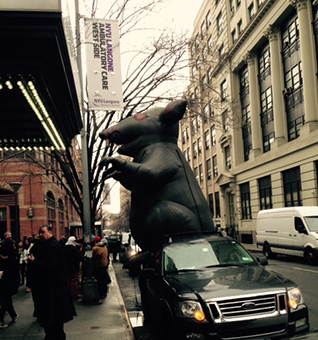The fight between Michael Stern’s JDS Development Group and a prominent construction trade group spread to a real estate conference Thursday morning, as protesters rallied outside and, in one instance, shouted from the audience.
Moments before the end of Bisnow’s sixth annual NYC Multifamily Summit, developer Ian Bruce Eichner said in his final thoughts that he likes “what Michael Stern is doing,” referring to the proposed supertall condominium tower at 111 West 57th Street that JDS is developing along with Kevin Maloney’s Property Markets Group. Eichner said he wanted to “figure out how to do more projects with nonunion labor.”
Eichner’s comment was met with resounding boos by some members of the audience, and Santos Rodriguez, director of community affairs for the Building and Construction Trades Council of Greater New York, shouted “Wrong!” from his seat. Rodriguez reiterated the trade association’s recent criticisms over the developers’ push to build the tower sans any use of union workers, arguing that the workers need to support their families.
Stern, also on the panel, responded that the biggest threat to development projects right now is uncertainty over 421a tax abatements.
In protest, union workers outside the New World Stages theater had set up the now-notorious giant inflatable rat and held up a banner that said, “While Michael Stern is addressing his audience, what’s happening at his construction site?”
The conference featured three panels with mortgage brokers, investment sales brokers and developers. Other notable panelists included Scott Alper from Witkoff, the Lightstone Group’s Mitchell Hochberg, Town Residential’s Anna Zarro, Meridian Capital Group’s Ronnie Levine, JLL’s Dustin Stolly and TerraCRG’s Adam Hess.

Union rat outside New World Stages in Midtown (credit: Mark Maurer)
The panelists discussed the wave of foreign investment in the city, emerging neighborhoods and the risks facing the multifamily market.
Hochberg said his firm has played it very safe and acquired very few buildings in recent years. Buying at the right basis and with low leverage is key, he said.
“We’re in the fifth or sixth inning of a nine-inning game,” Hochberg said, referring to the state of the overall New York City real estate market. Lightstone’s current projects include a 700-unit Gowanus apartment building and four Moxy hotels with Marriott.
Discussing the influx of Chinese capital, Eichner said it can’t compare to the boom of Japanese construction companies in the city in the 1980s.
“I can’t picture the Chinese getting their arms around a five-year project in Gowanus because they would need to accept all the uncertainty with the zoning risks,” Eichner said. In fact, Chinese firms such as the Greenland Group have shown a willingness to enter ground-up development ventures, including Atlantic Yards/Pacific Park.
Eichner pointed to rising construction costs, the need for workforce affordable housing – not for low-income tenants – and the impact of the U.S. dollar on luxury residential deals as key issues plaguing the market. He also said that there are too many choices for buyers of apartments at boutique projects in the West Village, Chelsea and Soho — projects with no views and few amenities.
“If you look at data from Douglas Elliman, Corcoran Sunshine or an upside-down banana, there’s virtually no sales at these apartments in the last six months,” Eichner said.
There is not much of an inventory crunch in this part of the market, Stern said.
Yosef Katz, managing director at GFI Realty Services, said the multifamily market boom in Bushwick and Bedford-Stuyvesant is “kind of done.”
Hess jokingly asked Katz if he mistakenly meant Williamsburg.
“The sales volume is just too high,” Katz said. “We’ll get to the stats later. … Cap-rate guys are few and far between – they’re priced out.”
Weighing in on the changing Brooklyn climate, Hochberg said he was recently at a bar in Gowanus with his colleagues in suits when a group of young people approached them.
“They called us bridge-and-tunnel people,” Hochberg said.
